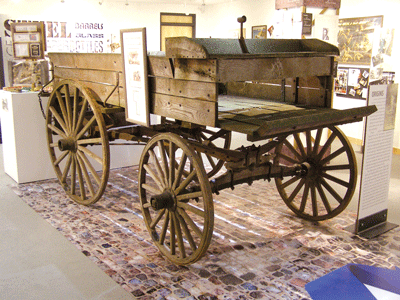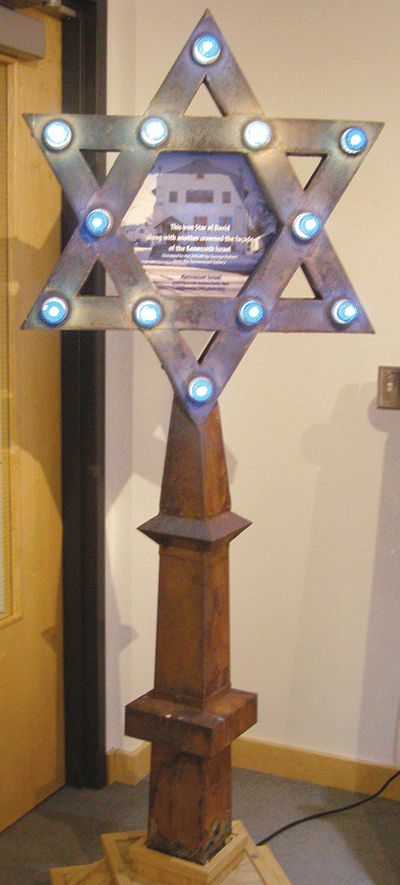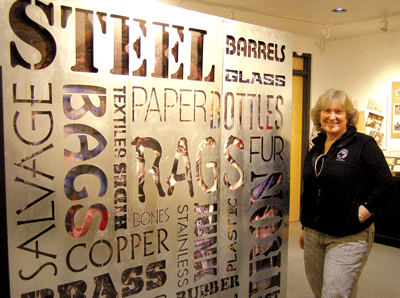By ERIN ELLIOTT BRYAN / Community News Editor
“The Jew who visits the farmer and tries to buy the old rubber… must persuade the farmer that it is better to sell old rubber, even at a few cents, than to burn it.”
— Ninth Biennial Report of the Bureau of Labor of the State of Minnesota, 1903-1904
This year, Passover begins on Friday, April 22 — the same date on which Earth Day has fallen each year since it was first commemorated in 1970. And this year there is more significant overlap between the two with a new exhibit that is on display at the Sabes JCC in St. Louis Park, Peddlers to Processors: Scrap Stories from the Upper Midwest.
The comprehensive exhibit celebrates the state’s Jewish peddlers and “junk men,” who organizers say were the “original recyclers.”
“They were recycling everything because everything had a value to someone,” said Jamie Heilicher, president of the Jewish Historical Society of the Upper Midwest (JHSUM), which produced the exhibit.

Peddlers to Processors begins in the hallway outside of the Tychman Shapiro Gallery, where a timeline of immigration is presented. According to Myrna Orensten, a JHSUM board member and curator of the exhibit, some two and a half million Jews immigrated to the United States from the harsh circumstances of Eastern Europe’s Pale of Settlement between 1880 and 1924.
These new immigrants had little to no education and were pushed westward, with many settling in the Upper Midwest — the Upper Peninsula of Michigan, Wisconsin, Minnesota, North and South Dakota, and Iowa — where they created this industry out of necessity. Some of the earliest settlers began trading furs with the Indians, and later immigrants became peddlers of rags, paper, oil and grease, pots and pans, bottles and scrap metal.
Among those immigrants was Orensten’s grandfather, Joseph Edward Davis, who began as a laborer for Duluth Iron & Metal and then founded West End Iron & Metal and Duluth Hide and Fur.
“These were the people who started synagogues, started organizations, they were Zionists, and they funded their relatives to come over,” Orensten said. “They built Jewish communities from nothing.”
And while each city and small town seemed to have a “Jewish junk man,” they were not always looked upon favorably. Publicity for the exhibit says they were “barely tolerated” and the Calhoun Beach Club in Minneapolis had a small plaque that read, “No Jews, peddlers or dogs allowed.”
Even the Ninth Biennial Report of the Bureau of Labor of the State of Minnesota, 1903-1904, stated: “It is an absolutely necessary function in our civilization and yet with what singular contempt the waste gathering business is treated!”
Still, these Jewish peddlers persisted in the industry, some progressing from horse and wagon to truck or becoming dealers and sophisticated scrap processors. Many of the families were related or intermarried, and some of today’s largest companies include third-, fourth- or fifth-generation leadership.
Family business
The centerpiece of the exhibit is the more than 100-year-old peddler cart used by Hyman Kaplan, who began H.S. Kaplan Scrap Iron and Metal Co. in Northfield, Minn., and continued as the family moved to St. Paul. Bob Kaplan is now the fourth generation in the family scrap business, working for Northern Metal Recycling/Great Western.
Orensten’s parents, Rieva Davis and Sherman Orensten, owned Chicago Iron and Supplies in Ashland, Wisc., and later Sherman Orensten and Sons in Eau Claire, where they lived for a time to be closer to a Jewish community. Orensten’s brother Lloyd now runs the Ashland operation, and her brother Eddie, a metal trader who now works for Alliance Steel.
“Wherever you went, you always had a friend,” Orensten said of the industry. “I’ve taken photos of scrap yards in Austria and Poland. You don’t get out of the scrap business.”
Another highlight of the exhibit is an iron Star of David salvaged from the former Kenesseth Israel Synagogue on Plymouth Avenue in North Minneapolis. It has been rewired with working lights.
One visitor to the exhibit, a man in his 60s, was particularly touched by that piece. His father was an electrician and used to go up to the roof of the synagogue to change the bulbs.
“It’s amazing what people connect with,” Orensten said.

Orensten has done a significant amount of research for the exhibit and, among her finds, was the original articles of incorporation for the Junk Peddlers’ Protective Association, which operated from 1916-1976 and was designed to protect peddlers from dealers. Also on display is an $8 million check from the City of Minneapolis to American Iron and Supply, owned by Harry Isaacs, which settled an 11-year lawsuit alleging that the company lost more than $100 million because the city blocked a massive metal shredder that was to be built along the banks of the Mississippi River.
Orensten noted that many of the scrap yards and processing plants were built near water and railroad tracks, including the Mississippi River and the harbor in Duluth — Duluth’s Canal Park was once a massive scrap yard. Some of the waterfront sites are now desired by cities and developers for more valuable uses.
World War II demand
Another aspect of the exhibit is the importance of scrap during World War II, when drives were held to collect, among other things, copper and tin that could be used to make armaments.
As Bing Crosby sang in a massive wartime advertising campaign, “Junk ain’t junk no more, ’cause junk can win the war.”
Other notable leaders in the Minnesota scrap business are also featured in the exhibit, including the Isaacs, Karon, Rappaport, Dworsky, Miller, Leder and Kaplan families.
The industry changed over the last decade, including in the Twin Cities when, in 2015, Minneapolis let its last barge through the Upper St. Anthony Falls lock on the Mississippi River due to the invasion of Asian carp. Today, many of the largest scrap businesses have been sold or consolidated, with several now owned by European or Chinese companies.
The incredible evolution of this multibillion-dollar industry is chronicled in Junkyard Planet, a book by journalist Adam Minter, who is also the son of an American junkyard owner.
“The Chinese now are like the original Jewish immigrants,” writes Minter, regarding their prominence in sorting scrap.

Orensten, who began working on this exhibit in December 2013, pointed out that recycling programs are now run by cities and counties, and many residents take for granted the opportunity to throw items into a bin that will collected curbside.
Peddlers to Processors will be displayed at the Sabes JCC through May 26, and part of the exhibit will move to the St. Paul JCC in June. Orensten encourages people to visit the exhibit and share their own personal stories about the Jewish scrap peddlers.
“It was fun to have a project I was really passionate about. I learned so much more than I ever imagined,” Orensten said. “But this is just the starting point.”
***
Peddlers to Processors: Scrap Stories from the Upper Midwest, an exhibit produced by the Jewish Historical Society of the Upper Midwest (JHSUM), is on display through May 26 in the Tychman Shapiro Gallery and Shared Walls Exhibition Areas at the Sabes JCC, 4330 Cedar Lake Rd. S., St. Louis Park.
In conjunction with the exhibit, the JCC will host a panel discussion, featuring five people who are in or are retired from the scrap business, 2 p.m. Sunday, May 1; and “Preserving History: A Community Scanning Event, an opportunity for historical photos to be digitized on the spot, 4 to 7 p.m. Tuesday, May 17.
For information, visit: www.scrapstories.org or: www.sabesjcc.org.
(American Jewish World, 4.22.16)



















